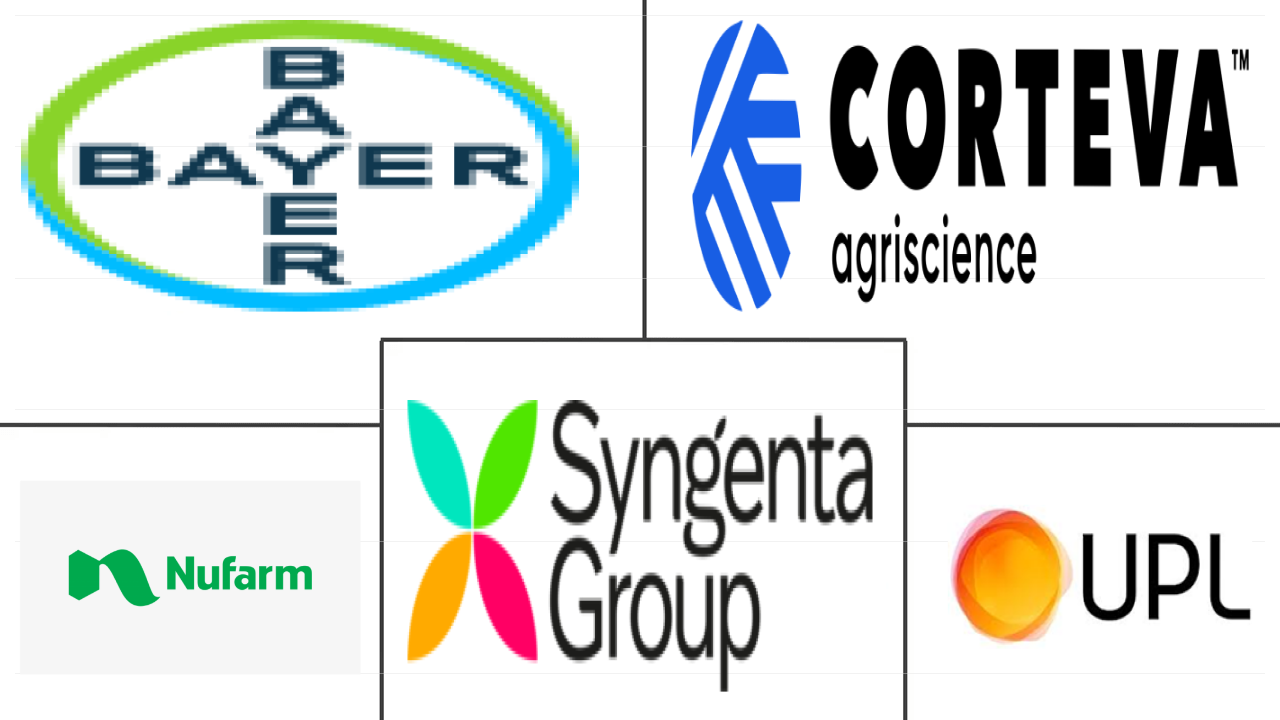Market Size of asia pacific herbicide Industry
|
|
Study Period | 2017 - 2029 |
|
|
Market Size (2024) | USD 7.13 Billion |
|
|
Market Size (2029) | USD 9.59 Billion |
|
|
Largest Share by Application Mode | Soil Treatment |
|
|
CAGR (2024 - 2029) | 6.12 % |
|
|
Largest Share by Country | China |
Major Players |
||

|
||
|
*Disclaimer: Major Players sorted in no particular order |
Asia Pacific Herbicide Market Analysis
The Asia Pacific Herbicide Market size is estimated at 7.13 billion USD in 2024, and is expected to reach 9.59 billion USD by 2029, growing at a CAGR of 6.12% during the forecast period (2024-2029).
7.13 Billion
Market Size in 2024 (USD)
9.59 Billion
Market Size in 2029 (USD)
6.76 %
CAGR (2017-2023)
6.12 %
CAGR (2024-2029)
Largest Segment by Application Mode
46.84 %
value share, Soil Treatment, 2023
Herbicide soil treatment application provides a more effective way to control various weed species in the early growth stage, resulting in market growth for soil treatment mode.
Largest Segment by Crop Type
56.61 %
value share, Grains & Cereals, 2023
Weed species such as barnyard grass, wild oats, green foxtail, purslane, and pigweeds cause major yield losses and need higher herbicide application to control these weeds.
Largest Segment By Country
27.96 %
value share, China, 2023
The rise in weed infestations by intensive agricultural practices to meet food security needs and higher cultivation areas has increased herbicide usage in the country.
Leading Market Player 1
13.25 %
market share, Bayer AG, 2022

Bayer AG manufactures innovative herbicide products that control grasses and broad-leaved weeds in major crops, including rice, corn, wheat, soybean, and cotton.
Leading Market Player 2
11.55 %
market share, Syngenta Group, 2022

Syngenta invests more in R&D activities to expand its product portfolio by adding new products like Gendarme MX 1 for paddy rice, resulting in the growth of the company's strength.
The market is being driven by increasing weed infestation and associated yield losses in crops
- The Asia-Pacific region is home to a diverse range of crops, encompassing staple food crops like rice, wheat, corn, and soybeans, as well as cash crops such as cotton, sugarcane, fruits, and vegetables, which face challenges from several weed species. In 2022, the soil treatment method accounted for the largest share of 46.7% in the Asia-Pacific herbicide market, representing a value of USD 3.0 billion. Soil treatment involves the direct application of herbicides to the soil, serving as an effective means of weed control. This method can be utilized either before planting or after crop emergence, targeting weed seeds, seedlings, or established weeds present in the soil.
- In 2022, foliar application of herbicides held a market share of 32.7% and was valued at USD 2.1 billion. This method is highly effective in targeting broadleaf weeds, sedges, grasses, and even aquatic weeds. By directly applying herbicides to the foliage of these weeds, maximum absorption and control can be achieved. The flexibility of foliar application allows farmers to target weeds during their active growth stages for optimal results.
- In 2022, chemigation accounted for 18.9% of herbicide application methods, valued at USD 1.2 billion. This growth is attributed to the increasing adoption of micro-irrigation systems and the ease of herbicide application, ensuring uniform distribution throughout the cropland.
- Fumigation can provide effective and targeted weed control, especially in enclosed environments where other methods may be less effective. It can reach weed seeds, root systems, and weed propagules that are difficult to control through other means.
- Owing to the advantages and specificity of each method, the market for each method is anticipated to grow during the forecast period.
The use of herbicides for major crops like rice is growing across the region
- The herbicide market in Asia-Pacific witnessed steady growth during the historical period, with the region occupying a significant share of the global herbicide market in 2022. Butachlor, propanil, pretilachlor, 2,4-D, bispyribac-sodium, and cyhalofop-butyl are the commonly used herbicides in the region.
- Rice is by far the most important crop in Asia; the region accounts for 90% of the world's production and consumption of rice. Herbicides are mostly used for grains and cereals in the Asia-Pacific as the region is the largest exporter and producer of staple grains such as rice. The grains & cereals segment occupied a share of 56.6% by value in 2022.
- Many countries in the region have adopted the Integrated weed Management method that entails the use of all available compatible control tactics to minimize yield losses. Newly introduced weeds that would require immediate eradication before they spread to other areas can be controlled with the use of herbicides. It was observed that combining cultural management practices and judicious herbicide usage resulted in higher yields of about 10% to 15% in the Nueva Ecija and Iloilo provinces of the Philippines, respectively.
- However, the occurrence of herbicide resistance in weed populations presents a big challenge as it limits herbicide choices for effective weed management. At the same time, governments of various countries like Japan are investing in research initiatives to discover new weeds and their subsequent herbicides. Such policies are encouraging farmers to adopt crop protection practices that aim to contribute to the growth of the segment. The segment is expected to record a CAGR of 6.1% during the forecast period (2023-2029).
Asia Pacific Herbicide Industry Segmentation
Chemigation, Foliar, Fumigation, Soil Treatment are covered as segments by Application Mode. Commercial Crops, Fruits & Vegetables, Grains & Cereals, Pulses & Oilseeds, Turf & Ornamental are covered as segments by Crop Type. Australia, China, India, Indonesia, Japan, Myanmar, Pakistan, Philippines, Thailand, Vietnam are covered as segments by Country.
- The Asia-Pacific region is home to a diverse range of crops, encompassing staple food crops like rice, wheat, corn, and soybeans, as well as cash crops such as cotton, sugarcane, fruits, and vegetables, which face challenges from several weed species. In 2022, the soil treatment method accounted for the largest share of 46.7% in the Asia-Pacific herbicide market, representing a value of USD 3.0 billion. Soil treatment involves the direct application of herbicides to the soil, serving as an effective means of weed control. This method can be utilized either before planting or after crop emergence, targeting weed seeds, seedlings, or established weeds present in the soil.
- In 2022, foliar application of herbicides held a market share of 32.7% and was valued at USD 2.1 billion. This method is highly effective in targeting broadleaf weeds, sedges, grasses, and even aquatic weeds. By directly applying herbicides to the foliage of these weeds, maximum absorption and control can be achieved. The flexibility of foliar application allows farmers to target weeds during their active growth stages for optimal results.
- In 2022, chemigation accounted for 18.9% of herbicide application methods, valued at USD 1.2 billion. This growth is attributed to the increasing adoption of micro-irrigation systems and the ease of herbicide application, ensuring uniform distribution throughout the cropland.
- Fumigation can provide effective and targeted weed control, especially in enclosed environments where other methods may be less effective. It can reach weed seeds, root systems, and weed propagules that are difficult to control through other means.
- Owing to the advantages and specificity of each method, the market for each method is anticipated to grow during the forecast period.
| Application Mode | |
| Chemigation | |
| Foliar | |
| Fumigation | |
| Soil Treatment |
| Crop Type | |
| Commercial Crops | |
| Fruits & Vegetables | |
| Grains & Cereals | |
| Pulses & Oilseeds | |
| Turf & Ornamental |
| Country | |
| Australia | |
| China | |
| India | |
| Indonesia | |
| Japan | |
| Myanmar | |
| Pakistan | |
| Philippines | |
| Thailand | |
| Vietnam | |
| Rest of Asia-Pacific |
Asia Pacific Herbicide Market Size Summary
The Asia Pacific herbicide market is experiencing significant growth, driven by the region's diverse agricultural landscape, which includes both staple and cash crops. The market is characterized by various herbicide application methods, such as soil treatment, foliar application, and chemigation, each offering unique advantages for weed control. Soil treatment, which involves applying herbicides directly to the soil, is particularly effective for pre-planting or post-emergence weed management. Foliar application targets weeds during their active growth stages, while chemigation benefits from the adoption of micro-irrigation systems for uniform herbicide distribution. The region's reliance on herbicides is further underscored by the prevalence of weed infestations, which pose significant challenges to crop yields, particularly in staple grains like rice, wheat, and corn.
The market's expansion is supported by the adoption of integrated weed management practices and the increasing use of herbicides per hectare, particularly in countries like Japan and Myanmar. However, challenges such as herbicide resistance and the need for new weed control solutions are prompting governments and companies to invest in research and development. The market is moderately consolidated, with major players like Bayer AG, Corteva Agriscience, Nufarm Ltd, Syngenta Group, and UPL Limited leading the industry. Collaborations and partnerships among these companies aim to enhance crop protection technologies and develop eco-friendly solutions, reflecting the ongoing innovation and adaptation within the Asia Pacific herbicide market.
Asia Pacific Herbicide Market Size - Table of Contents
-
1. MARKET SEGMENTATION (includes market size in Value in USD and Volume, Forecasts up to 2029 and analysis of growth prospects)
-
1.1 Application Mode
-
1.1.1 Chemigation
-
1.1.2 Foliar
-
1.1.3 Fumigation
-
1.1.4 Soil Treatment
-
-
1.2 Crop Type
-
1.2.1 Commercial Crops
-
1.2.2 Fruits & Vegetables
-
1.2.3 Grains & Cereals
-
1.2.4 Pulses & Oilseeds
-
1.2.5 Turf & Ornamental
-
-
1.3 Country
-
1.3.1 Australia
-
1.3.2 China
-
1.3.3 India
-
1.3.4 Indonesia
-
1.3.5 Japan
-
1.3.6 Myanmar
-
1.3.7 Pakistan
-
1.3.8 Philippines
-
1.3.9 Thailand
-
1.3.10 Vietnam
-
1.3.11 Rest of Asia-Pacific
-
-
Asia Pacific Herbicide Market Size FAQs
How big is the Asia Pacific Herbicide Market?
The Asia Pacific Herbicide Market size is expected to reach USD 7.13 billion in 2024 and grow at a CAGR of 6.12% to reach USD 9.59 billion by 2029.
What is the current Asia Pacific Herbicide Market size?
In 2024, the Asia Pacific Herbicide Market size is expected to reach USD 7.13 billion.

